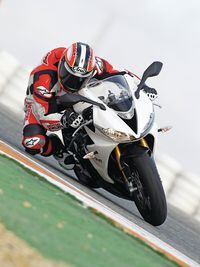Vibration on skin and muscle is a therapeutic and often pleasurable sensation. Vibration transferred directly to any of the 206 bones of the skeleton or the internal organs is neither therapeutic nor pleasurable.
Bodies don’t function well in the presence of vibration. Certain frequencies bring about disorientation, blurred vision, or a decrease in manual coordination. It’s not unusual to experience these sensations during or after aggressive riding.
Two vestibular organs in our inner ear control our physical orientation and motion detection. This is our data-acquisition system. Three fluid-filled, semi-circular canals keep us correctly oriented to the earth. The slightest head motion causes the fluid to move and tickle tiny, hair-like sensors that inform our sense of balance and direction. This mechanism, in turn, coordinates our body position and visual tracking.
When the vestibular organs are shaken or vibrated, the liquid sloshes and jiggles, sending conflicting and confusing signals to our brain. In the same way that a severe engine misfire would create havoc in a corner, the body, being shaken, experiences intermittent signals that prevent it from moving accurately and smoothly.
Racers are particularly sensitive to “chatter”—the rapid grip and release of traction that is occasionally felt at high speeds and steep lean angles. The vibrational resonance of chatter—typically 8 to 20 cycles per second—falls within the spectrum that causes complications for humans. Heavy braking can also induce physical discomfort. Stiff-arming the bars transmits front-end forces directly to the shoulders, neck, and head, where our vestibular organs reside. Gripping the tank with your knees can reduce this. Death-gripping the bars further transmits body vibrations—keep your grip relaxed. Using your legs to suspend your body to limit bouncing in the saddle can also reduce tension.
Head and neck tension further upsets the inner ear. The less tension in your neck, the better it absorbs excess vibration. Likewise, your back; a relaxed, slightly bowed back is preferable. The body is an efficient vibration-canceling device provided its connective tissue remains relaxed and the bones remain in alignment. Good body positioning follows this datum as a guideline.
Being very relaxed in the saddle is possible even during intense riding, but we still need to be solidly connected to the bike—preferably with our legs—to provide the necessary stability to control the machine. This is a trade-off we have to live with, but with training and small adjustments we can come up with a compromise to satisfy the demands of both the body and the bike.
First, find the most common body positions you assume while cornering. Then, experiment and adjust yourself on the bike so each and every joint is in its most neutral, least tense position. Learning to ride this way will ensure you only feel the good vibrations when riding, and remain more connected to the bike.











/cloudfront-us-east-1.images.arcpublishing.com/octane/HXOUJXQWA5HBHGRO3EMJIGFMVI.jpg)

/cloudfront-us-east-1.images.arcpublishing.com/octane/3TIWWRV4JBBOLDVGRYECVVTA7Y.jpg)
/cloudfront-us-east-1.images.arcpublishing.com/octane/KIX5O23D5NAIBGFXBN3327DKZU.jpg)
/cloudfront-us-east-1.images.arcpublishing.com/octane/7GJYDUIPXRGMTMQKN6ONYOLBOU.jpg)
/cloudfront-us-east-1.images.arcpublishing.com/octane/MUQLOVLL2ZDGFH25ILABNBXKTI.jpg)
/cloudfront-us-east-1.images.arcpublishing.com/octane/TNOU5DNE2BC57MFPMGN2EIDXAM.jpg)
/cloudfront-us-east-1.images.arcpublishing.com/octane/GTCXACQGJ5HAPDTGWUQKDEH44E.jpg)
/cloudfront-us-east-1.images.arcpublishing.com/octane/S35YGSEMEZB4BLTDJTSZPF4GLA.jpg)
/cloudfront-us-east-1.images.arcpublishing.com/octane/5UOT6HPX2JFMRJAX6EH45AR4MQ.jpg)
/cloudfront-us-east-1.images.arcpublishing.com/octane/OKWOJWAKP5EP3OACCRRWPCIX2Q.jpg)
/cloudfront-us-east-1.images.arcpublishing.com/octane/2WF3SCE3NFBQXLDNJM7KMXA45E.jpg)
/cloudfront-us-east-1.images.arcpublishing.com/octane/G4MG6OUCJNBSHIS2MVVOTPX65E.jpg)
/cloudfront-us-east-1.images.arcpublishing.com/octane/IIGGWFOTOJGB7DB6DGBXCCMTDY.jpg)
/cloudfront-us-east-1.images.arcpublishing.com/octane/QSTCM6AVEZA5JJBUXNIQ3DSOF4.jpg)
/cloudfront-us-east-1.images.arcpublishing.com/octane/U4I7G625B5DMLF2DVIJDFZVV6M.jpg)
/cloudfront-us-east-1.images.arcpublishing.com/octane/B6XD6LS6IVCQPIU6HXDJSM3FHY.jpg)
/cloudfront-us-east-1.images.arcpublishing.com/octane/ICL63FEDDRDTTMINYICCEYGMDA.jpg)
/cloudfront-us-east-1.images.arcpublishing.com/octane/FCGZHQXRBZFLBAPC5SDIQLVF4I.jpg)
/cloudfront-us-east-1.images.arcpublishing.com/octane/WNOB6LDOIFFHJKPSVIWDYUGOPM.jpg)

/cloudfront-us-east-1.images.arcpublishing.com/octane/X33NU3E525ECRHXLNUJN2FTRKI.jpg)
/cloudfront-us-east-1.images.arcpublishing.com/octane/6KKT5NNL2JAVBOXMZYS5ZO76YA.jpg)
/cloudfront-us-east-1.images.arcpublishing.com/octane/J5RKG5O455GMPGQRF2OG6LRT7A.jpg)